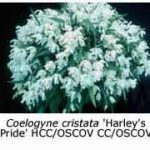New growers, who have already mastered the cultivation of cymbidiums and Australian native dendrobiums, occasionally ask me what they can try next. The first two that I recommend are usually species orchids, one native to Mexico and the other to northern India, namely Laelia anceps and Coelogyne cristata, respectively. Both are able to withstand temperatures down to freezing and up to the high thirties, and also to survive prolonged dry spells. They are very forgiving orchids, withstanding more neglect than most other orchids. Of course, they grow and flower better if not subjected to such indignities.
There are well over a hundred different species in the genus Coelogyne, which ranges over a wide range of habitats from near sea level to an altitude of almost 3000 m. Coelogyne cristata is widespread in the lower Himalayas at altitudes between 1400 m and 2300 m. It was once especially abundant around Darjeeling, which is located in northern India between Bhutan and Nepal. No doubt the trees have long since been cleared for tea plantations, but Joseph Hooker, who collected orchids and other plants in 1848-1850, recorded that “On the ascent from Darjeeling the straight shafts of many of the timber trees are literally clothed with a continuous garment of white-flowered coelogynes, which bloom in a profuse manner, whitening their trunks like snow”. Hooker later succeeded his father as director of the Royal Botanic Gardens at Kew ( London) and eventually received a knighthood.
The inflorescences of Coelogyne cristata are pendulous, so for best effect it should be grown in a hanging basket, using pine bark, Sphagnum moss or a blend of the two as the potting medium. Once established, plants grow rapidly and after a few years the bulbs and growths are likely to cover their basket completely. Frequent repotting is neither necessary nor advisable. I have seen plants growing quite happily in the same container for ten years or more.
Coelogyne cristata should be watered every few days throughout summer, daily in very hot weather, and occasionally treated with a weak liquid fertilizer, such as Aquasol®. During winter, coelogynes need much less water. Some growers withhold water completely but I water my plants every two weeks. Good light in winter helps to promote flowering in spring. It is most important that the developing buds and flowers be kept dry. Even a few drops of water on the flowers may lead to unsightly brown spots, ruining what may otherwise be a spectacular display. Care should also be taken to avoid water lodging in the new growths, as it may cause them to rot.
Coelogyne cristata resents repotting; small divisions may sulk for months before resuming growth. So make sure that you buy a well-established division and try to keep its potting mix intact when you transfer the plant to a basket. After a few years it should develop into a specimen plant, which will often reward you with a spectacular floral display. Other species that can also be grown without heat in Melbourne include Coelogyne elata, C. barbata, C. corymbosa and C. mooreana.

